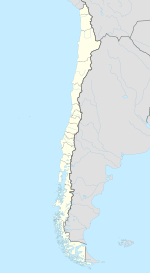Greater Santiago
| Santiago de Chile | |||||
|---|---|---|---|---|---|

Collage of Santiago, left to right, top to bottom: Cerro Santa Lucía, panoramic view of Santiago, La Moneda, Statue of the Immaculate Conception, Torre Entel, National Museum of Fine Arts and National Library of Chile, Torre Telefónica, San Francisco Church and Estación Central Santiago Metro station and Railway Station.
|
|||||
|
|||||
| Nickname(s): "The City of the Island Hills" | |||||
| Coordinates: 33°27′S 70°40′W / 33.450°S 70.667°WCoordinates: 33°27′S 70°40′W / 33.450°S 70.667°W | |||||
| Country |
|
||||
| Region |
|
||||
| Province | Santiago Province | ||||
| Foundation | 12 February 1541 | ||||
| Founded by | Pedro de Valdivia | ||||
| Government | |||||
| • Intendant | Claudio Orrego | ||||
| Area | |||||
| • Total | 641 km2 (247.6 sq mi) | ||||
| Elevation | 521 m (1,706 ft) | ||||
| Population (2015) | |||||
| • Total | 6,158,080 | ||||
| • Density | 8,470/km2 (21,925/sq mi) | ||||
| Demonym(s) | Santiaguinos (-as) | ||||
| Time zone | CLT (UTC−4) | ||||
| • Summer (DST) | CLST (UTC−3) | ||||
| Postal code | 8320000 | ||||
| Area code(s) | +56 2 | ||||
| Website | Official website | ||||
Santiago de Chile [sanˈtjaɣo ðe ˈtʃile] is the capital and largest city of Chile. It is also the center of its largest conurbation. Santiago is located in the country's central valley, at an elevation of 520 m (1,706 ft) above mean sea level.
Founded in 1541, Santiago has been the capital city of Chile since colonial times. The city has a downtown core of 19th century neoclassical architecture and winding side-streets, dotted by art deco, neo-gothic, and other styles. Santiago's cityscape is shaped by several stand-alone hills and the fast-flowing Mapocho River, lined by parks such as Parque Forestal. The Andes Mountains can be seen from most points in the city. These mountains contribute to a considerable smog problem, particularly during winter. The city outskirts are surrounded by vineyards and Santiago is within a few hours of both the mountains and the Pacific Ocean.
Santiago is the cultural, political and financial center of Chile and is home to the regional headquarters of many multinational corporations. The Chilean executive and judicial powers are located in Santiago, but Congress meets mostly in nearby Valparaíso. Santiago is named after the biblical figure St. James.
In Chile, there are several entities which bear the name of "Santiago" that are often confused. The Commune of Santiago, sometimes referred to as "downtown" or "Central Santiago" (Santiago Centro), is an administrative division that comprises roughly the area occupied by the city during its colonial period. The commune, administered by the Municipality of Santiago and headed by a mayor, is part of the Santiago Province headed by a provincial governor, which is in itself a subdivision of the Santiago Metropolitan Region headed by an intendant. Despite these classifications, when the term "Santiago" is used without another descriptor, it usually refers to what is also known as Greater Santiago (Gran Santiago), a territorial extension defined by its urban continuity that includes the Commune of Santiago in addition to 36 other communes, which together comprise the majority of the Santiago Province and some areas of neighboring provinces (see Political divisions).
...
Wikipedia



